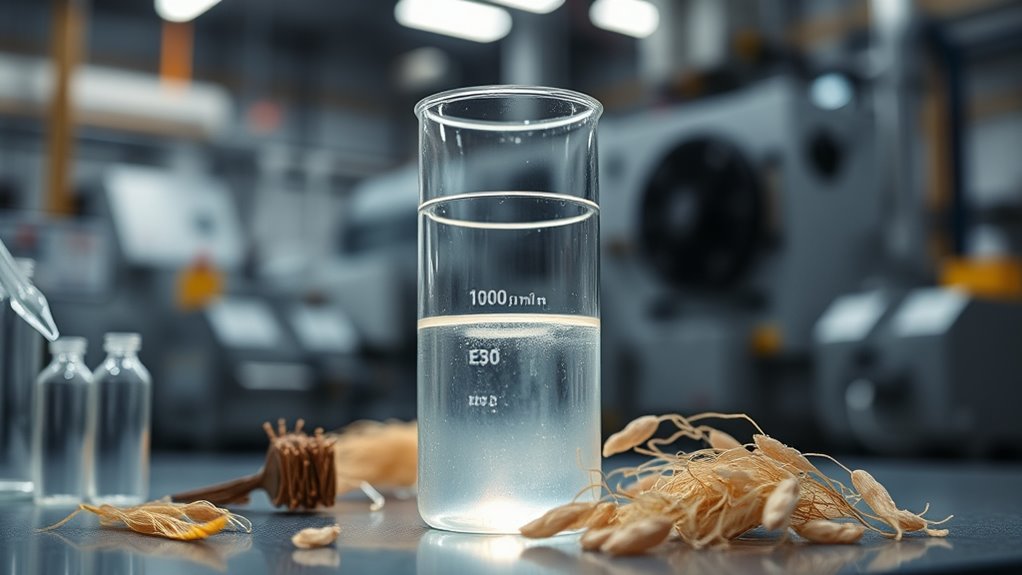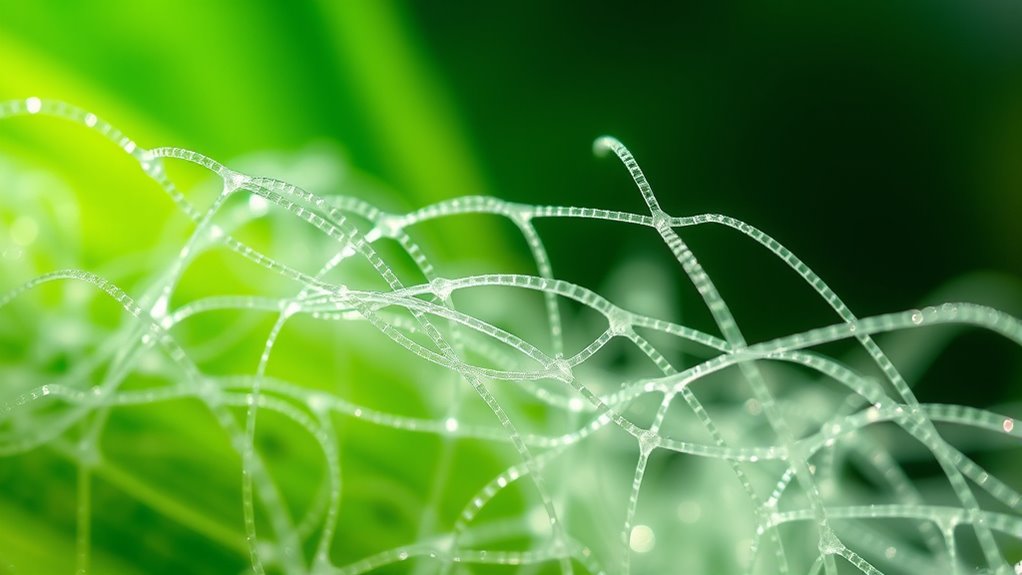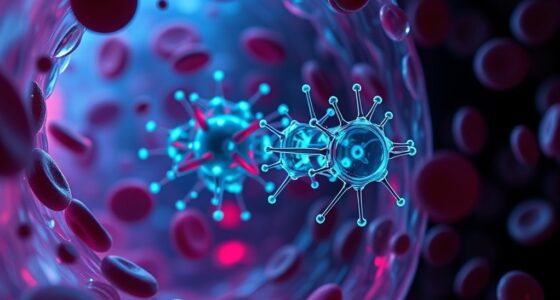Nanocellulose, sourced from biomass through methods like mechanical, chemical, and enzymatic processes, offers a sustainable alternative to traditional materials. It boasts remarkable strength, high surface area, and biodegradability, making it ideal for eco-friendly packaging, composites, and filtration systems. Its renewable nature supports environmental goals by reducing plastic waste and carbon footprint. Continuing to explore this versatile nanomaterial will reveal how it can revolutionize industries while promoting sustainability and innovation.
Key Takeaways
- Nanocellulose is a biodegradable, renewable nanomaterial derived from biomass through mechanical, chemical, or enzymatic processes.
- It offers high strength, surface area, and crystallinity, making it ideal for sustainable packaging, composites, and water filtration.
- Production methods can be environmentally friendly, utilizing mild conditions and reducing energy consumption.
- Nanocellulose supports eco-friendly industries by replacing plastics and synthetic fibers with biodegradable alternatives.
- Challenges include scalable production, ensuring purity, and effective integration into commercial applications for broader sustainability impact.
Methods of Producing Nanocellulose From Biomass

Producing nanocellulose from biomass involves several effective methods, each designed to break down cellulose fibers into nanoscale structures. You can use mechanical techniques like high-pressure homogenization, where intense forces disintegrate fibers into nanocrystals. Another approach is chemical treatments, such as acid hydrolysis, which selectively removes amorphous regions, leaving behind crystalline nanocellulose. Enzymatic methods employ specific enzymes to gently cleave cellulose chains, offering a more environmentally friendly option. Sometimes, a combination of these methods works best, like pre-treating biomass chemically before applying mechanical forces. Each process allows you to tailor the properties of the nanocellulose produced, depending on your intended application. These methods are versatile, scalable, and essential for transforming biomass into valuable, sustainable nanomaterials. Additionally, understanding sound vibrations can enhance processing techniques by promoting cellular regeneration and overall health during manufacturing.
Key Properties and Characteristics of Nanocellulose

Nanocellulose exhibits remarkable properties that make it a highly versatile nanomaterial. It has an exceptional strength-to-weight ratio, making it stronger than steel on a per-weight basis, yet lightweight. Its high surface area enhances reactivity and bonding potential, which is useful for composite materials. You’ll find nanocellulose to be highly crystalline, providing rigidity and stability. It also displays excellent biodegradability and biocompatibility, allowing it to break down naturally without harming the environment. Its hydrophilic nature means it easily absorbs water, which can influence its behavior in applications. Additionally, nanocellulose’s optical transparency and ability to form thin films make it suitable for coatings and packaging. These combined properties make nanocellulose a promising, sustainable nanomaterial for various innovative uses.
Industrial Applications Driving the Green Revolution

How is nanocellulose transforming industry to support a sustainable future? It’s enabling greener alternatives across multiple sectors. Its lightweight, strong, and biodegradable nature reduces reliance on plastics, promoting eco-friendly packaging. In the paper industry, nanocellulose enhances strength and reduces material usage. It’s also revolutionizing composites, creating durable, sustainable materials for automotive and construction uses. Additionally, nanocellulose improves water filtration systems, making them more efficient and environmentally friendly. You’ll find it in textiles, offering sustainable options for clothing and apparel. Its versatility accelerates innovation, helping industries cut carbon footprints and minimize waste. Incorporating cybersecurity measures ensures that the deployment of nanocellulose-based technologies remains protected from digital threats and vulnerabilities.
Environmental Benefits and Sustainability Aspects

Thanks to its renewable and biodegradable nature, nanocellulose offers significant environmental benefits by reducing reliance on fossil fuels and decreasing plastic waste. Since it’s derived from biomass, it’s a sustainable resource that can be replenished quickly, unlike non-renewable materials. Its biodegradability ensures it breaks down naturally without harming ecosystems, minimizing plastic pollution. Using nanocellulose in products can lower carbon footprints, as its production generally consumes less energy compared to synthetic alternatives. Additionally, its abundant availability from plant sources makes it an eco-friendly choice for various industries. Incorporating nanocellulose fosters a circular economy, encouraging recycling and reducing waste. Understanding environmental benefits of nanocellulose can help promote its adoption as a sustainable material. Overall, adopting nanocellulose contributes to sustainable development, helping you reduce environmental impact while promoting greener, cleaner alternatives in everyday applications.
Challenges and Future Perspectives in Nanocellulose Development

Despite its many environmental advantages, developing nanocellulose faces several significant hurdles. Scaling production while maintaining quality remains a challenge, as current methods are often costly and energy-intensive. Achieving consistent, high-performance nanocellulose requires overcoming issues related to purity and functionalization. Environmental and safety concerns about chemical treatments used in processing need addressing to guarantee sustainability. Standardizing measurement techniques is essential for comparing results across studies. Additionally, integrating nanocellulose into commercial products demands overcoming compatibility and dispersion issues. Studies also suggest that Glycolic Acid Benefits for Skin can inspire innovative approaches to surface modification and functionalization of nanocellulose to enhance its properties.
Frequently Asked Questions
How Does Nanocellulose Compare Cost-Wise to Synthetic Nanomaterials?
You’ll find nanocellulose generally costs less than synthetic nanomaterials, mainly because it’s derived from abundant biomass like wood and plant fibers. Its production utilizes renewable resources and simpler processes, which help keep expenses down. While synthetic nanomaterials often involve costly chemicals and energy-intensive manufacturing, nanocellulose’s eco-friendly and scalable methods make it a more economical choice, especially for large-scale applications.
What Specific Types of Biomass Are Most Effective for Nanocellulose Extraction?
You should focus on using wood pulp, agricultural residues like wheat straw and corn stalks, and certain grasses such as bamboo for nanocellulose extraction. These biomasses are rich in cellulose, making them highly effective sources. They are abundant, renewable, and often inexpensive, which helps reduce costs. By selecting these specific materials, you can maximize yield and quality, ensuring a sustainable and cost-efficient production process for nanocellulose.
Are There Health Risks Associated With Nanocellulose Production or Use?
You might wonder if nanocellulose poses health risks, like lurking shadows. Current research shows that, when handled properly, nanocellulose is generally safe, as it’s biocompatible and biodegradable. However, inhaling loose particles or dust during production can irritate your lungs or skin. So, it’s essential to use protective gear and proper ventilation, turning your workspace into a fortress that keeps any potential risks at bay.
How Scalable Are Current Nanocellulose Manufacturing Processes?
You’ll find that current nanocellulose manufacturing processes are becoming increasingly scalable, thanks to advancements in extraction techniques and equipment. While some methods still face challenges in large-scale production, ongoing research aims to improve efficiency and reduce costs. As you explore this field, expect to see more industrial applications emerge, making nanocellulose a viable sustainable material for various industries. Keep an eye on innovations that push scalability even further.
What Regulatory Hurdles Exist for Commercialization of Nanocellulose Products?
Imagine you’re in the 21st century, where regulatory hurdles for nanocellulose include safety assessments, environmental impact studies, and standardization issues. You’ll need to navigate evolving regulations from agencies like the EPA or EMA, which may lag behind technological advances. Ensuring product safety, labeling, and biodegradability compliance can delay commercialization. Staying proactive by collaborating with regulators and conducting thorough research helps you overcome these hurdles efficiently.
Conclusion
Think of nanocellulose as the seeds of a green revolution, sprouting innovation from biomass. As you explore its sustainable properties, you realize it’s like a tiny but mighty force transforming industries and protecting our planet. Embracing this material is like planting a forest—each step forward nurtures a cleaner, greener future. With continued research and dedication, nanocellulose can grow into a towering pillar of sustainable innovation.








